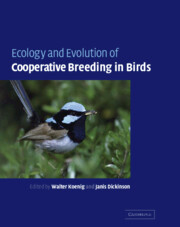Book contents
- Frontmatter
- Contents
- List of contributors
- Introduction
- 1 Evolutionary origins
- 2 Delayed dispersal
- 3 Fitness consequences of helping
- 4 Parental care, load-lightening, and costs
- 5 Mating systems and sexual conflict
- 6 Sex-ratio manipulation
- 7 Physiological ecology
- 8 Endocrinology
- 9 Incest and incest avoidance
- 10 Reproductive skew
- 11 Joint laying systems
- 12 Conservation biology
- 13 Mammals: comparisons and contrasts
- 14 Summary
- Names of bird and mammal species mentioned in the text
- References
- Taxonomic index
- Subject index
11 - Joint laying systems
Published online by Cambridge University Press: 02 December 2009
- Frontmatter
- Contents
- List of contributors
- Introduction
- 1 Evolutionary origins
- 2 Delayed dispersal
- 3 Fitness consequences of helping
- 4 Parental care, load-lightening, and costs
- 5 Mating systems and sexual conflict
- 6 Sex-ratio manipulation
- 7 Physiological ecology
- 8 Endocrinology
- 9 Incest and incest avoidance
- 10 Reproductive skew
- 11 Joint laying systems
- 12 Conservation biology
- 13 Mammals: comparisons and contrasts
- 14 Summary
- Names of bird and mammal species mentioned in the text
- References
- Taxonomic index
- Subject index
Summary
Joint nesting is a relatively rare form of cooperative breeding in which two or more breeding group members of the same sex contribute genes to a clutch of eggs and cooperate in the care of young (Brown 1987; Vehrencamp 2000). Traditionally, joint nesting referred to multiple-female clutches. However, with the development of DNA techniques for assigning paternity, a growing number of cooperative species with shared-paternity clutches have been discovered. Joint-female (or communally laying) systems and joint-male (or cooperatively polyandrous) systems exhibit many important differences. Nevertheless, several avian joint-female species are also characterized by the presence of two or more adult males who share paternity to some degree. Here we focus on the diversity of joint-female systems, referring the reader to Chapter 10 and other reviews for discussions of breeding systems with male cobreeding (Faaborg and Patterson 1981; Hartley and Davies 1994; Ligon 1999).
Most joint-female species are non-passerines. By contrast, helper-at-the-nest species, as well as cooperatively polyandrous species, are found among both the passerines and non-passerines. There may be a good explanation for this pattern. Communally laying species all share one important feature: males make a large contribution to incubation and care of the young. In some joint-female species males perform all of the incubation and subsequent care, whereas in others the males perform more than half of the incubation, including nocturnal incubation.
In a survey of the phylogenetic origins of communal-laying species, all were found to arise in taxa with a history of strong male incubation (Vehrencamp 2000).
- Type
- Chapter
- Information
- Ecology and Evolution of Cooperative Breeding in Birds , pp. 177 - 196Publisher: Cambridge University PressPrint publication year: 2004
- 49
- Cited by

